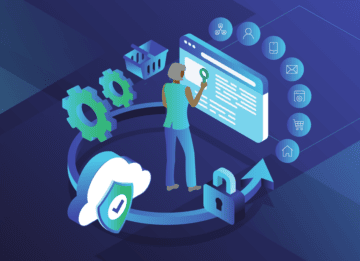Strike Sales Gold Prospecting with Identity Resolution
The business of marketing and sales tech is booming. Technologist and blogger Scott Brinker released the 2017 edition of the marketing technology landscape (Martech 5000), which reported that the number of available marketing solutions grew to a total of 5,381 (from 4,891 unique companies). The organizational technology stack continues to balloon. By one estimate alone, the average enterprise uses more than 90 cloud services.
Yet despite the proliferation of software such as Hubspot, Marketo, Eloqua, Oracle, Pardot, and others, sales staff still prospect with incomplete or disparate customer data. The result? Manual data entry, added steps, lost time, and longer sales cycles. Sales leads are even less accurate, with missing customer data that is too thin to mine or take action.
Moreover, the problem of prospecting—of locating and prioritizing the best sales contacts to engage with—has never been more prevalent. Why? Partial data won’t work when it comes to finding your next customer. You can’t target prospects and create customers with just an email, phone, or social handle. You need complete data to truly understand customers and provide a high-quality journey.
The majority of customer interactions now happens over multiple visits, across a number of channels. Understanding customer behavior in this context (e.g., what are their social interests, both professionally and away from the office? What devices do they use? What brands to they prefer?) is a complex undertaking. But it’s a worthwhile undertaking.
When you gather customer data and contextualize it, you begin to understand who to target, where to start, and what message to deliver. You shorten the buying cycle by identifying the right place and time to act throughout the journey. Ultimately, you find more customers, close bigger deals, and grow strategic accounts. Moreover, you reduce churn through more targeted engagement.
How Does Identity Support Prospecting?
According to Pew Research, 90% of U.S. households contain at least one of these devices (smartphone, desktop/laptop computer, tablet or streaming media device), with the typical (median) American household containing five of them.
Connecting these devices to the individual using them provides a broader insight into who your customer is, their interests, and their behaviors. In addition to understanding who they are, you can determine the ways your customer is most comfortable interacting with your brand.
Identity-based prospecting lets you better:
- Target and segment prospects with greater accuracy: identify the individuals that offer the greatest return on investment and then reach out to them using precise attributable characteristics.
- Maintain your customer experience: You can link identities across touchpoints and channels to track the customer journey and provide consistent treatment.
- Exclude the wrong prospect from campaigns: Remove the people who don’t fit your profile to ensure the right people get the relevant message.
Five Steps to Improve Your Prospecting
Identity resolution allows you to connect with new prospects that match your search criteria. In addition, you identify your highest value prospects. You can use identity data to engage with clients on their terms, based on their profile, using an abundance of customer intelligence.
Once in place, identity resolution allows you to execute your prospecting strategy.
- Make it personal
Online searches provide inaccurate data that can harm an opportunity as much as help. Social data helps, but gleaning useful information from the more than 100+ social networks available today can be an arduous undertaking to say the least. Identity resolution does the work for you–using machine learning and other sophisticated techniques—to provide a single, comprehensive view of an individual. That allows you to do several things–such as reference a specific problem that the prospect has encountered, a hobby or interest they enjoy.
Look-alike modeling offers similar prospecting promise. First-party data is not always the best place to look for new customers. Lookalike modeling can help you expand your base by finding more people who share attributes with your existing base—whether it’s by geography, job title, or organization.
- Remain relevant
Timely interaction with prospects is of paramount importance. Understanding customers, and creating journeys they crave, involves getting real-time updates that reflect their most recent activities and affinities. Once you resolve a lead’s multiple online and offline accounts, you build out their profile–and most important, receive continuous near real-time updates–within your existing CRM. You understand where to focus, how to begin, and how to remain relevant throughout the conversation.
- Act human
Most people don’t want to be sold, they want to heard. And no one likes to communicate with someone who comes across as inauthentic or robotic. Applying details like wishing someone a happy birthday, referencing a recent business trip or job change, helps make deeper connections. Today’s most innovative businesses connect with their customers on a human level. Whether you work with business professionals or consumers, interaction that feels like it comes from an actual person prompts attention in the brave new world of 21st-century sales.
- Supply value
An overused word bandied about in marketing, sales, and organizational lexicon, value is still the gold standard for earning trust. Help customers solve their problems. And to do this, you need to understand their business, their interests, and their challenges to determine how your brand can provide worth that begins before the sale. Without sounding too idealistic or abstract, the sales process is about the customer, not the deal. There are several ways to do this based on your business model–conduct an audit, perform pilot analytics, send over 3rd party research, etc.
- Keep it casual
There’s no greater method to melt away precepts and establish trust to keep your interactions conversational in tone. Natural language, as opposed to jargon or sales-speak, will do more to help connect and close deals. The key to prospecting is not selling your company, product, or even yourself (as the cliché goes). Focus on using relaxed language to establish a mutually beneficial relationship.
The Identity ROI
What’s exciting about the potential for resolving problems (or opportunities) such as prospecting with identity resolution is that it’s groundbreaking technology. Forward thinking businesses employing identity resolution range from enterprises to startups, in industries from CRM/SaaS to Fraud Management, Consumer Brands to Financial Services. Yet it’s still a relatively burgeoning, and soon to be exploding, solution that offers a distinct competitive advantage. The question is, what growth-oriented organizations will beat out their competitors first to yield results for years to come?
Recent Blogs
-
 February 25, 2025 Introducing Email Signals: Unlock Powerful Email Engagement Insights Customer 360, Customer Experience, Marketing & Sales, Enrich API
February 25, 2025 Introducing Email Signals: Unlock Powerful Email Engagement Insights Customer 360, Customer Experience, Marketing & Sales, Enrich API -
 August 28, 2024 The Sales Rep's Guide to Maximizing Productivity with Website Visitor Data Acumen, Media Personalization, Marketing & Sales
August 28, 2024 The Sales Rep's Guide to Maximizing Productivity with Website Visitor Data Acumen, Media Personalization, Marketing & Sales -
 August 6, 2024 Turn Visitors into Leads: How to Install the Acumen Web Tag in 5 Easy Steps Acumen, Website Recognition
August 6, 2024 Turn Visitors into Leads: How to Install the Acumen Web Tag in 5 Easy Steps Acumen, Website Recognition